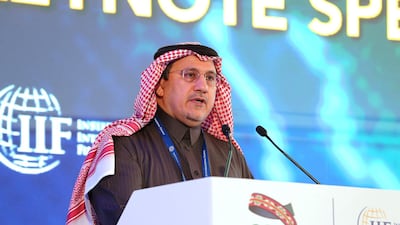Saudi Arabia, the Arab world’s biggest economy, does not share the International Monetary Fund’s outlook on the kingdom's economy and is more optimistic about growth despite the impact of the Covid-19 pandemic, its central bank governor said.
“We remain less pessimist,” Saudi Arabian Monetary Authority governor Ahmed Alkholifey, said in a Bloomberg TV interview on Monday. “We believe in the resilience of the Saudi economy, particularly, with support both from fiscal and monetary policies,” he said without giving Sama’s own projection for growth this year.
In June as the IMF revised down its forecast for the global economy to a 4.9 per cent contraction it also projected Saudi Arabia's economy to shrink 6.8 per cent. That was a deeper revision than the 2.3 per cent contraction estimate the Washington-based lender made in April.
The kingdom's economy is projected to rebound in 2021, expanding 3.1 per cent, according to the fund.
The virus has infected close to 11.5 million people worldwide and killed more than 534,000, according to Johns Hopkins University, which is tracking the outbreak. The IMF projects a cumulative loss to the global economy of over $12 trillion (Dh44tn) over this year and next, as a result of the virus. Although most economies have started opening up, the rate of infection is still on the rise in Americas and Asia, including the US, Brazil and India.
Saudi Arabia's economy is also gradually emerging from a strict lockdown. However, the kingdom has put in place strict social distancing measures and is allowing only limited number of pilgrims to perform Hajj this year to contain the spread of Covid-19.
The kingdom's economy contracted only 1 per cent in the first three months of the year, however, the major chunk of the lockdown impact was in the second quarter, Mr Alkholifey said, without giving the second quarter contraction figure.
“The recent frequency data, which is point of sales [figures] have shown a pickup, as a result of more activity after opening up of the economy,” he said.
Based on consumer spending data, Saudi Arabia has seen a 50 per cent pickup in the first half of the year in terms of volumes and a 12 per cent increase in value, he added.
Mr Alkholifey said it is “too early” to say if the kingdom will see a V-shaped recovery, as downside risks remain such as a second wave of the virus or more negative developments in the global economy.
“We see the light at the end of the tunnel, yet we remain vigilant, to be honest,” he said.
Two thirds of governments globally, including Saudi Arabia, have topped up their fiscal support to offset the effects of the pandemic, pumping about $11tn into their economies, compared with $8tn in April.
The kingdom, since the outbreak, has rolled out 142 stimulus initiatives with a total value of 214 billion Saudi riyals ($57bn/Dh210bn) to support individuals, private sector businesses and investors.
In June, Sama injected 50bn riyals into its banking sector as part of its efforts to boost liquidity and enhance the lending capacity of financial institutions. The move came after the central bank's March announcement of a 50bn riyal stimulus package. The kingdom also rolled out measures to support small and medium sized enterprises (SMEs).
Mr Alkholifey said the central bank it is still studying “indicators” and may or may not extend the stimulus packages, some of which are expiring in September.
The kingdom has not seen “significant changes” in the central bank’s foreign-currency reserves in June, he said citing preliminary end-of-month data.
“The level is still comfortable as we see it right now: $450bn with around 40 months of coverage of imports of good and about 80 per cent of broader stock of money,” he said.


